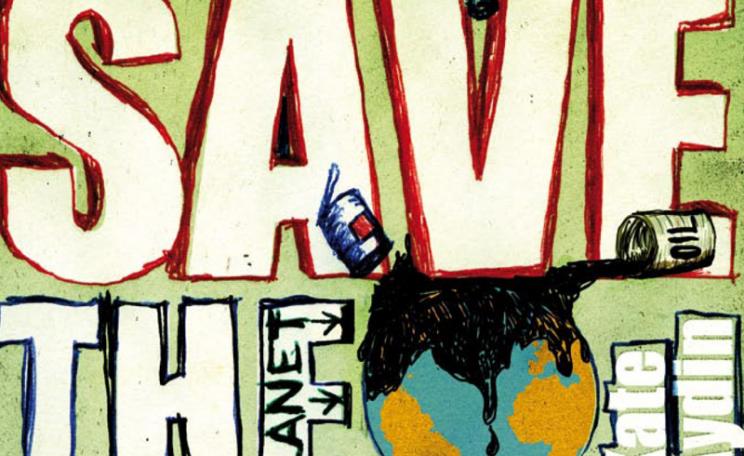Penguins fight for survival on the last ice mountain, frothing waves rise to terrifying heights and a grim lion-woman gazes dispassionately at Colin the Camel struggling across a desert strewn with skeletons and debris, to the sound of dull metallic crashes and disembodied voices.
Not the usual paraphernalia of a school foyer in South East London perhaps, but set secondary school students an art project on the theme of climate change and, apparently, this is what you can expect.
This grand installation, entitled ‘Some Like It Hot’, was unveiled at the green-thinking Charter School in Southwark on Monday 20th July. It is the seedbed project for the global online climate change initiative ‘Cool it Schools’ – a website launched in June allowing people all over the world to showcase their projects on climate change, sharing their concern and ideas for the environment.
Cool it Schools is the brainchild of artist, lecturer and mother Jane Langley, who was struck by the idea almost a year ago while listening to a lecture on global warming by Thomas Friedman, author of Hot, Flat and Crowded.
She remains the creative dynamo behind this global online revolution-in-the-making, encouraging the use of art and imagination in bringing home to young people the reality of climate change.
'Art is a great way of bringing a topic together,' she said. 'The kids had done climate change in the curriculum, but hadn’t really engaged with it.'
She believes the importance of teaching children about environmental issues does not lie solely in preparing them to be engaged citizens of the future.
'Who gets adults to do their bidding? It’s kids – you’re going to do something about it for your kids because it’s their future,' she said.
So, in their final week of the year, teachers and pupils set to work during lessons to create 17 displays, each contributed by an individual subject area, based on different ideas on the theme of climate change, and made using recycled materials and props and costumes donated by the National Theatre.
Inspire, don't scare
Jane said she had to pitch the right amount of material for students to get involved and excited, but not so much as to overwhelm them.
12-year-old twins Taormina and Larissa Miller said it was scary seeing what might happen in 100 years or so.
'It’s kind of happy because you can still change it,' said Taormina, 'but it’s quite sad because you know a lot of people can’t be bothered.'
Involving pupils from all age groups, the project was completed with the help of Jane, a team of 12 graduates of City and Guilds of London Art School, an intern curator, a sound artist and a guest poet. The result is an impressive and dynamic multimedia collection of vast creations, inventive sound, thoughtful words and energetic performance.
The displays include: a tower of tabloid papers and gaffa tape, spouting pollution and filth; a giant vision of the last ice mountain on earth, breaking and drifting into a neighbouring display of a wild sea towering over windfarms; and a huge desert scattered with ‘the bones of our civilisation’. Postcards and letters to friends, dated 2050, tell of the aftermath of a climate-induced flood that engulfed London.
The school’s atrium was not all gloom, however. It also plays host to an enormous green model of an eco-town featuring green roofs and city gardens, populated by protesting citizens, betraying the unquenchable positivity of the students. Giant footprints around some of the displays feature pupils’ pledges to reduce their carbon footprints.
Sound artist Lisa Busby helped a small group of sixth formers to recreate and record sounds to fit the installations. She thinks art can play crucial roles in reinforcing educational concepts.
'It’s nice that this was so interdisciplinary, and that art was the leading discipline,' she said. 'It’s easy to brush art under the carpet in education and say it’s not valid.'
Every fifteen minutes or so, guests browsing the room with drinks and olives in hand are silenced by a group of girls performing increasingly passionate dramatic readings of two climate change poems written by Year 10 students.
Everyone involved in the project believes in the learning benefits that artistic expression can provide.
'Single events like this will have a much more lasting impact on learning,' said headteacher David Sheppard. 'They will remember it, it allows them to understand more richly.'
'The kids have learned subliminally by having fun,' said Jane. 'And kids who were very naughty at the beginning were transformed into model students.'
Drama teacher Lucy Williams praised the project’s positive nature. 'When climate change is first suggested it’s all so depressing, but this installation is all about positivity and community,' she said.
Act local, think global
Jane’s hope is that the Cool it Schools website will create a global community of young people able to express their concerns about climate change, and their willingness to do their bit.
She is directing the project towards COP15 – the crucial UN Climate Change Conference that will take place in Copenhagen between December 7 and 18.
By this time she aims to have made a film including contributions from children worldwide, which she hopes will be screened in Copenhagen and then around the world.
Schools, museums and cultural centres are among the institutions called upon to register and begin their own showcase.
Jane intends the site to provide insight into the attitudes, aspirations and wishes of young people. The global reach will enable them to understand how climate change is affecting their peers and feel part of a team. Members already include schools in Borneo, China, the Amazon Rainforest and Ghana and a museum in Australia, and their creative writings, photos, films and recordings will soon be uploaded.
The site has links to information about climate change, and an extensive list of ideas for topics and projects.
In order to appeal to younger children, Jane has enlisted the help of her attention-grabbing miniature dachshund, Mole, to act as Cool it Schools’ official mascot. The dog even sports a coat bearing the project’s logo, and Jane has been told that Vivienne Westwood would like to make her a designer version to raise the scheme’s profile.
After an uphill funding struggle, eventually resorting to relying on her own savings, Jane has found that interest in her site has escalated rapidly. Parties such as Plan UK, the Royal Society of Art and the British Film Institute are now eager to be involved, and a distilled version of Some Like It Hot is to be exhibited at the Carnegie Library and King’s College Hospital.
Visit www.coolitschools.com to see more photos of The Charter School’s exhibition and to get involved.







